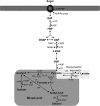Lactate dehydrogenase is the key enzyme for pneumococcal pyruvate metabolism and pneumococcal survival in blood
- PMID: 25245810
- PMCID: PMC4249287
- DOI: 10.1128/IAI.02005-14
Lactate dehydrogenase is the key enzyme for pneumococcal pyruvate metabolism and pneumococcal survival in blood
Abstract
Streptococcus pneumoniae is a fermentative microorganism and causes serious diseases in humans, including otitis media, bacteremia, meningitis, and pneumonia. However, the mechanisms enabling pneumococcal survival in the host and causing disease in different tissues are incompletely understood. The available evidence indicates a strong link between the central metabolism and pneumococcal virulence. To further our knowledge on pneumococcal virulence, we investigated the role of lactate dehydrogenase (LDH), which converts pyruvate to lactate and is an essential enzyme for redox balance, in the pneumococcal central metabolism and virulence using an isogenic ldh mutant. Loss of LDH led to a dramatic reduction of the growth rate, pinpointing the key role of this enzyme in fermentative metabolism. The pattern of end products was altered, and lactate production was totally blocked. The fermentation profile was confirmed by in vivo nuclear magnetic resonance (NMR) measurements of glucose metabolism in nongrowing cell suspensions of the ldh mutant. In this strain, a bottleneck in the fermentative steps is evident from the accumulation of pyruvate, revealing LDH as the most efficient enzyme in pyruvate conversion. An increase in ethanol production was also observed, indicating that in the absence of LDH the redox balance is maintained through alcohol dehydrogenase activity. We also found that the absence of LDH renders the pneumococci avirulent after intravenous infection and leads to a significant reduction in virulence in a model of pneumonia that develops after intranasal infection, likely due to a decrease in energy generation and virulence gene expression.
Copyright © 2014, American Society for Microbiology. All Rights Reserved.
Figures






References
Publication types
MeSH terms
Substances
LinkOut - more resources
Full Text Sources
Other Literature Sources
Medical
Molecular Biology Databases

